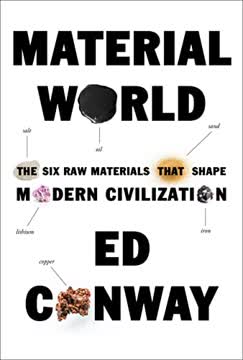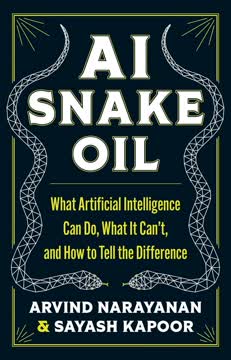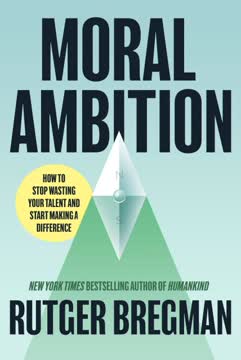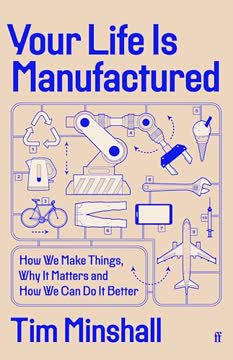Key Takeaways
1. Manufacturing is Pervasive Yet Invisible, and Alarmingly Fragile
Unless you are currently floating naked through space, you are right now in immediate contact with multiple manufactured products.
Our manufactured world. Everything around us, from the clothes we wear to the devices we use, has been made and delivered by someone. This pervasive reality of manufacturing often remains invisible, much like a sewage system—essential but out of mind until something goes wrong. This invisibility has worrying consequences, as it disconnects us from the processes and impacts of production.
Fragility revealed. Recent global crises, such as the COVID-19 pandemic, starkly exposed the fragility of our manufacturing systems. The "great toilet roll grab" illustrated how a sudden surge in demand for a seemingly simple product could overwhelm a finely tuned supply chain, leading to empty shelves and public disbelief. This vulnerability stems from systems optimized for efficiency, often at the expense of resilience.
Complex interdependencies. The manufacturing world is a mind-bogglingly complex web of interconnected activities, from raw material extraction to final delivery. This complexity, coupled with a relentless focus on lean manufacturing to minimize waste and cost, has inadvertently created systems with little redundancy or "Plan B." When disruptions occur—be it a ship blocking a canal or a global health crisis—the impact spreads rapidly, leaving us vulnerable to shortages.
2. Production Adapts to Volume and Variety, Driven by Industrial Revolutions
All factories do the same thing: they take some inputs and do some kind of processing (people follow a method using machines and materials) to convert them into more valuable outputs.
Factory archetypes. The type of factory needed is dictated by the volume and variety of products to be made. From a small domestic kitchen making a single batch of brownies (job shop) to a large sugar refinery producing bulk material continuously (continuous flow), factories follow distinct operational templates. In between are batch production (like a bakery making hundreds of Chelsea buns or an F1 team building a few racing cars) and mass production (like a car factory assembling thousands of EVs).
Industrial evolution. Manufacturing has undergone several transformative industrial revolutions, each shifting from person-based to machine-based production and increasing productivity and scale.
- First Industrial Revolution (late 1700s): Interchangeable parts (Honoré Blanc's guns), machine tools (Wilkinson's cannon borer), and steam power enabled mass manufacturing.
- Second Industrial Revolution (late 1800s): Assembly lines (Henry Ford), widespread steel production, and electricity further scaled production. Quality control (Deming, Toyota Production System) became crucial for defect-free output.
- Third Industrial Revolution (mid-1900s): Electronic computers and automation (robots) enhanced efficiency and responsiveness, connecting activities across the make-move-consume journey.
Trade-offs and standardization. Each revolution brought new ways to manage the trade-off between volume and variety. Mass production thrives on standardization, allowing machines to perform repetitive tasks with consistent quality. This historical progression shows how manufacturing constantly adapts its methods, machines, materials, and people to meet evolving demands.
3. Global Logistics: A Complex, Costly, and Vulnerable Dance
The fact that these vast external logistics systems work so well almost 100 per cent of the time is one of the most miraculous features of the manufacturing world.
The logic of movement. Manufacturing is inherently about movement, from raw materials entering a factory to finished products reaching consumers. This "logistics" involves intricate coordination, whether it's internal (conveyors in a factory) or external (global shipping). A bicycle's 20,000 km journey from China to the UK, involving multiple modes of transport and vast container ports like Felixstowe, exemplifies this complexity.
Outsourcing and globalization. Two major forces transformed external logistics: outsourcing, where companies specialize and rely on external suppliers, and globalization, enabled by innovations like Malcolm McLean's shipping containers. Containers standardized freight, drastically reducing transport costs and making it economically viable to manufacture goods in low-wage countries and ship them worldwide. This led to geographically dispersed supply chains.
Fragility and environmental cost. While efficient, this global system is alarmingly fragile, as demonstrated by the Ever Given blocking the Suez Canal, halting $10 billion in trade daily. Long supply chains also incur significant environmental costs, generating massive CO2 emissions (e.g., fish caught in Scotland, processed in China, sold back in the UK). Efforts to mitigate this include:
- Reshoring/Near-shoring: Bringing production closer to home to reduce transport distances and increase resilience.
- Cleaner transport: Developing electric/hydrogen trucks, wind-powered ships, and encouraging slower shipping speeds (20% slower = 34% less CO2).
The challenge lies in balancing economic efficiency with environmental sustainability and supply chain resilience.
4. Forecasting Demand: An Art and a Science to Satisfy Fickle Consumers
Forecasts are always wrong.
The customer conundrum. Manufacturers face the constant challenge of predicting what customers want, how many, and when. Unlike bespoke orders (like ceremonial uniforms), most demand is uncertain, making it difficult to optimize factory operations and supply chains. This tension between predictable production and unpredictable consumption drives the need for sophisticated demand forecasting.
Crystal balls and guesswork. Manufacturers use two main approaches to forecast demand:
- Learning from history: Analyzing past sales data (e.g., Cadbury Creme Eggs, Airbus orders) to identify trends and make quantitative predictions for existing products.
- Guessing the future: For new products (e.g., Apple Vision Pro, Post-it notes), this involves asking potential customers (often unreliable) or consulting experts (Delphi studies, sales teams) and using scenario planning. Henry Ford's famous quote, "If I had asked my customers what they wanted, they would have said a faster horse," highlights the difficulty of predicting demand for truly novel innovations.
Managing supply and demand. Manufacturers actively manage demand through advertising, pricing (e.g., premium pricing for peak demand), and offering counter-cyclical products (e.g., ice cream makers producing soup in winter). On the supply side, capacity planning (sales and operations planning) determines how to scale production. Strategies include:
- Level production: Maintaining steady output and using stock to absorb demand fluctuations (e.g., pens).
- Demand chasing: Rapidly adjusting production to match demand spikes (e.g., aircraft orders).
- Platform strategy: Designing products with shared components (e.g., VW MQB) to offer variety cost-effectively.
- Outsourcing/Servitisation: Leveraging external capacity or selling "power by the hour" (e.g., jet engines) to meet fluctuating needs and shift focus from product ownership to problem-solving.
5. Innovation Drives Constant Transformation, Often with Government Support
Manufacturing systems work best when everything is stable, when everyone knows what they are doing and when interruptions and changes are kept to a minimum.
The paradox of change. While stability is ideal for manufacturing, constant innovation is essential for survival and growth. This involves both disruptive "creative destruction" (e.g., Tesla challenging traditional automakers) and continuous incremental improvements (e.g., mobile phone evolution). The Kano model explains this: customer requirements shift from "delighters" to "performance" to "basic" features, forcing manufacturers to constantly innovate to differentiate.
From ICE to EV. The transition from internal combustion engine (ICE) to electric vehicles (EVs) is a prime example of large-scale transformation. Early EVs existed but were sidelined due to battery limitations and range anxiety. Tesla's success, driven by lithium-ion batteries and a disruptive approach, forced established automakers to adapt. This shift involves:
- Product simplification: EVs have fewer than half the components of ICE cars.
- Factory reconfiguration: Existing ICE factories must be heavily re-tooled, or new EV-specific factories built (e.g., Zeekr in China).
- Supply chain changes: New suppliers for batteries and electric motors, often located closer to assembly plants due to battery weight.
Government's role. Governments play a crucial role in de-risking and accelerating such transitions:
- Supply-side support: Funding research and development centers (e.g., UK's High Value Manufacturing Catapult, WMG, Omnifactory) to help firms scale new technologies and overcome adoption barriers.
- Demand-side stimulation: Offering subsidies for EV purchases, investing in charging infrastructure, and setting mandates (e.g., UK's 2030 ban on new petrol/diesel car sales).
- Managing unintended consequences: Providing retraining and welfare for workers displaced by technological change (e.g., Orgreave's transformation from mining town to AMRC hub).
6. Digitalization Connects and Empowers, Creating Smart, Hyper-Connected Systems
At the root of the transformation of the newsprint industry is digitalisation, a set of processes for capturing, analysing and communicating data in digital form.
The digital revolution. Digitalization has fundamentally reshaped manufacturing, moving from physical atoms to digital electrons for information delivery. This transformation, rooted in centuries of innovation, enables unprecedented data capture, analysis, and communication across the entire make-move-consume spectrum. Examples include:
- Pizza delivery: Real-time tracking of orders and drivers, seamless payment, and personalized choices.
- Jet engine maintenance: Sensors transmit flight data to engineers, enabling predictive maintenance and optimized operations.
- Smart factories: Zeekr's EV plant uses a private 5G network to collect data from thousands of sensors, allowing instant glitch detection, pre-emptive maintenance, and demand-chasing production.
Historical trajectory. Digitalization evolved through:
- Early automation: Jacquard's punched-card looms (1800s) for pattern control.
- Computing pioneers: Babbage's analytical engine, Ada Lovelace's first program.
- Data processing: Hollerith's census machines (leading to IBM).
- Electronic computers: EDSAC, LEO (Lyons Electronic Office) for business efficiency.
- Miniaturization: Transistors and microprocessors (Intel 4004 with 2,250 transistors, Apple M3 Max with 92 billion) enabled personal computers and widespread data access.
- Connectivity: ARPANET, the internet, and mobile phones created a globally interconnected "giant brain."
The Fourth Industrial Revolution. This era is characterized by the "Internet of Things" (IoT/IIoT), connecting billions of devices to generate massive data. This enables "digital twins"—virtual replicas of physical assets—for simulation and optimization. However, challenges remain:
- Uneven distribution: Small and medium-sized enterprises (SMEs) often lack resources for adoption.
- Human role: Automation and AI raise questions about job displacement and the quality of remaining human roles (e.g., low-paid delivery riders).
- AI's impact: AI augments decision-making (e.g., supply chain risk analysis) but also introduces "black box" decision-making concerns.
- System fragility: Reliance on the internet and the complex, costly, and globally concentrated semiconductor industry creates new vulnerabilities.
7. Blurring Boundaries: Healthcare Manufacturing Embraces Local and Personalized Production
The COVID-19 pandemic abruptly demonstrated the critical but complex role of manufacturing in keeping us alive and healthy.
Crisis as catalyst. The COVID-19 pandemic exposed critical fragilities in healthcare manufacturing, from PPE shortages to vaccine development. This crisis, however, also accelerated the adoption of innovative approaches, blurring the lines between production and consumption and integrating individuals and communities more deeply into manufacturing systems.
Accelerated medicine development. The rapid development of COVID-19 vaccines (under a year, compared to the usual 10-15 years) demonstrated what's possible with urgent goals, increased risk tolerance, and parallel development. This led to ambitious goals like the "100 Days Mission" for future pandemic responses. Innovations include:
- Distributed manufacturing: Modular, containerized GMP facilities (e.g., BioNTech's BioNTainers) can be deployed locally to produce medicines where needed, reducing cold chain complexities and supply chain risks.
- Personalized medicine: Moving towards treatments tailored to individual patients' unique physiology, lifestyle, and genetics. This envisions "pill-printers" in homes, delivering precise, on-demand medication.
Responsive medical device production. PPE and ventilator shortages highlighted the need for local, agile manufacturing. Non-medical firms (e.g., aerospace, vacuum cleaner manufacturers) repurposed their operations, and community makerspaces (e.g., Makespace) produced essential items like face shields. This demonstrated:
- Repurposing capability: Factories can adapt to produce diverse products in a crisis.
- Local resilience: Shorter supply chains increase reliability and reduce environmental impact.
- Collaboration: Digital tools enabled rapid coordination between diverse organizations.
Hospitals as factories. Hospitals, traditionally seen as consumers of manufactured goods, are increasingly recognized as manufacturing organizations themselves, producing everything from plaster casts to bespoke surgical devices. The shift to personalized medicine and "hospitals at home" further merges healthcare delivery with localized production, making patients active participants in their own manufacturing systems.
8. The Survival Imperative: Towards a Circular and Regenerative Future
Anyone who thinks that you can have infinite growth in a finite environment is either a madman or an economist.
Unsustainable practices. Current manufacturing practices, while meeting basic human needs for shelter, food, and clothing, are ironically jeopardizing long-term planetary survival. Manufacturing is the second-largest source of greenhouse gas emissions, produces phenomenal waste (e.g., 40% of food wasted globally), and is a major polluter. Examples include:
- Cement: 8% of global CO2 emissions, yet crucial for infrastructure.
- Food: 2.5 billion tonnes wasted annually, with 10% of emissions from uneaten food.
- Clothing: 1.2 billion tonnes of GHG emissions annually, 75% ends up in landfill, and "fast fashion" drives rapid disposal.
The circular economy. The concept of "sustainable development" (meeting present needs without compromising future generations) necessitates a shift from a linear "take-make-dispose" model to a "circular economy." This involves:
- Reduce: Minimizing material and energy consumption.
- Reuse: Extending product life through multiple uses.
- Recycle: Recovering materials for new products, ideally "upcycling" to higher value.
- Rethink: Shifting business models (e.g., "power by the hour" for jet engines, clothing rental) to incentivize durability and efficiency.
- Renovate/Repair: Retrofitting existing buildings and enabling product repair to reduce new production.
Path to regeneration. Exemplars like British Sugar's zero-waste factory (converting by-products into bioethanol, topsoil, and medicinal cannabis) and Jeanologia's water-saving denim finishing demonstrate the commercial viability of circularity. Start-ups like CarbonRe are using AI to incrementally improve efficiency in high-emission industries like cement. The ultimate goal is "regenerative manufacturing," where production actively contributes positively to the environment (e.g., factories producing purified water or clean energy).
Challenges and the way forward. Despite progress, significant hurdles remain:
- Scope 3 emissions: Over 70% of manufacturing emissions are indirect (supply chain, customer use), making accountability complex.
- Trade-offs: Balancing sustainability with quality, cost, and speed is challenging (e.g., "most sustainable" jeans).
- Inertia: Transforming complex, interconnected global systems requires immense collaborative effort and overcoming resistance to change.
- GDP fixation: Over-reliance on GDP as a measure of success can obscure environmental degradation and disincentivize sustainable practices.
However, "de-coupling" economic growth from environmental harm is happening, and increased data visibility empowers consumers and manufacturers to make better choices. Manufacturing is not just the problem; it is the solution, capable of delivering a more sustainable, resilient, and equitable future.
Last updated:
Review Summary
"Your Life Is Manufactured" receives mixed reviews, with an average rating of 3.74 out of 5. Readers appreciate its accessibility and engaging exploration of manufacturing processes. Many find it eye-opening and praise its optimistic tone. However, some criticize its simplistic approach and lack of depth. The book is commended for its insights into global supply chains and sustainability issues. While some readers find it captivating and educational, others feel it's better suited for high school students or those new to the subject. Overall, it's seen as a good introduction to manufacturing's impact on daily life.
Similar Books






Download PDF
Download EPUB
.epub digital book format is ideal for reading ebooks on phones, tablets, and e-readers.





